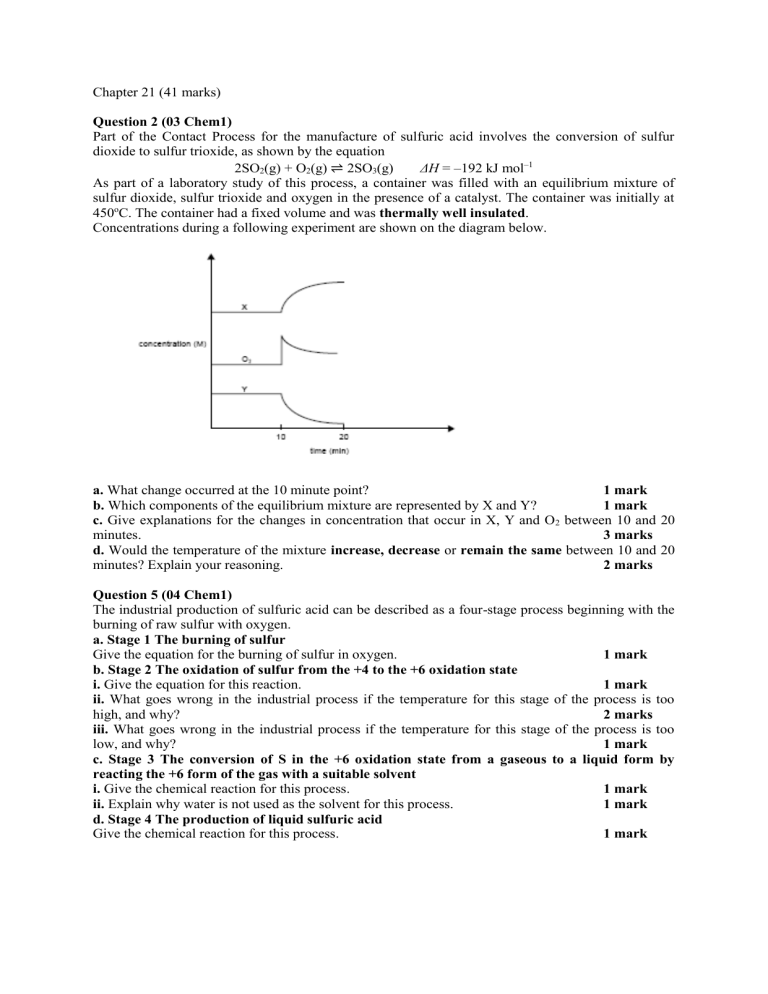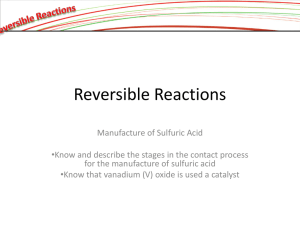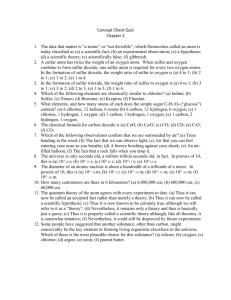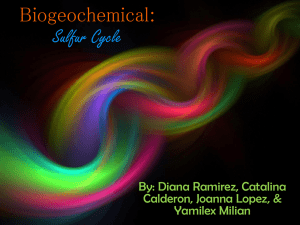Chapter 21 - CSC-year-12

Chapter 21 (41 marks)
Question 2 (03 Chem1)
Part of the Contact Process for the manufacture of sulfuric acid involves the conversion of sulfur dioxide to sulfur trioxide, as shown by the equation
2SO
2
(g) + O
2
(g) ⇌ 2SO
3
(g)
ΔH
= –192 kJ mol
–1
As part of a laboratory study of this process, a container was filled with an equilibrium mixture of sulfur dioxide, sulfur trioxide and oxygen in the presence of a catalyst. The container was initially at
450 o C. The container had a fixed volume and was thermally well insulated .
Concentrations during a following experiment are shown on the diagram below. a. What change occurred at the 10 minute point? b. Which components of the equilibrium mixture are represented by X and Y?
1 mark
1 mark c. Give explanations for the changes in concentration that occur in X, Y and O
2
between 10 and 20 minutes. 3 marks d. Would the temperature of the mixture increase, decrease or remain the same between 10 and 20 minutes? Explain your reasoning. 2 marks
Question 5 (04 Chem1)
The industrial production of sulfuric acid can be described as a four-stage process beginning with the burning of raw sulfur with oxygen. a. Stage 1 The burning of sulfur
Give the equation for the burning of sulfur in oxygen. b. Stage 2 The oxidation of sulfur from the +4 to the +6 oxidation state
1 mark i. Give the equation for this reaction. 1 mark ii. What goes wrong in the industrial process if the temperature for this stage of the process is too high, and why? 2 marks iii. What goes wrong in the industrial process if the temperature for this stage of the process is too low, and why? 1 mark c. Stage 3 The conversion of S in the +6 oxidation state from a gaseous to a liquid form by reacting the +6 form of the gas with a suitable solvent i. Give the chemical reaction for this process. ii. Explain why water is not used as the solvent for this process.
1 mark
1 mark d. Stage 4 The production of liquid sulfuric acid
Give the chemical reaction for this process. 1 mark
Question 5 (05 Chem1)
Sulfuric acid can be produced from mined sulfur via the Contact Process. The Þ rst two stages in the industrial production of sulfuric acid by this process are represented below. a. Give a reason why, in stage I, the molten sulfur is sprayed into the burner rather than being allowed to flow through it. 1 mark b. A conflict is involved in choosing the best temperature to be used in stage II, where the reaction is
2SO
2
(g) + O
2
(g) ⇌ 2SO
3
(g) i. Describe the nature of the conflict and explain how the conflict is resolved. 2 marks ii. Would increasing the pressure of the reacting mixture in the converter affect the amount of SO
3 produced in stage II? Explain your answer. 2 marks c. Sulfuric acid is a diprotic acid. The Þ rst ionisation reaction of sulfuric acid is complete while its second ionisation is that of a weak acid. Give chemical equations for both the first and second ionisation reactions of sulfuric acid. 2 marks d. Give one major industrial use of sulfuric acid. 1 mark
Question 8 (06 Chem1)
One of the steps involved in the industrial preparation of sulfuric acid is the oxidation of sulfur dioxide to sulphur trioxide according to the equation
2SO
2
(g) + O
2
(g) ⇌ 2SO
3
(g) a. Give the name or formula for the catalyst that is most widely used for this reaction. 1 mark b. The graph below shows the percentage conversion of sulfur dioxide to sulfur trioxide at equilibrium at 1 atm pressure and various temperatures.
There is almost complete conversion of sulfur dioxide to sulfur trioxide at 300°C. However, this reaction is performed at a higher temperature of approximately 450°C in industry. Why? 1 mark
c. Explain why i. high pressures would increase the equilibrium yield of sulfur trioxide in this reaction. 1 mark ii. atmospheric pressure is usually used in industry, even though high pressures increase the equilibrium yield of sulfur trioxide in this reaction.
1 mark d. A chemical reaction that involves sulfuric acid occurs in each of the following situations. Write a balanced chemical equation for each reaction, showing the states of all reactants and products. i. Dilute sulfuric acid is added to sodium carbonate solution.
ii. Sulfur trioxide gas is bubbled through concentrated sulfuric acid.
2 marks
1 mark iii. A piece of zinc metal is added to 6 M sulfuric acid. Zinc ions are formed as well as an oxide of sulphur in which sulfur exhibits an oxidation state of +4. 2 marks
Question 4 (07 Chem1)
Sulfur dioxide (SO
2
) is a chemical of major industrial significance. a. SO
2
gas can be produced in a reaction between concentrated sulfuric acid and nickel metal. A solution containing Ni 2+ ions is also formed.
Write balanced equations for the i. oxidation reaction ii. reduction reaction iii. overall reaction, showing the states of all reactants and products.
1 mark
1 mark
2 marks b. SO
2
can also be produced in a chemical reaction between zinc sulfate (ZnSO
3
) and hydrochloric acid according to the equation
ZnSO
3
(s) + 2H + (aq) → Zn 2+ (aq) + SO
2
(g) + H
2
O(l)
Is this reaction also a redox reaction? Explain your answer. 1 mark c. The SO
2 produced as a by-product of the extraction of lead from its ore can cause serious pollution.
In order to avoid releasing the SO
2
into the atmosphere it is often collected and used to produce chemicals of industrial importance. Give the formula of such a chemical. 1 mark d. The following pairs of statements refer to the reaction of SO
2
(g) with O
2
(g) in the presence of vanadium (V) oxide. Each statement contains one or more missing words. Circle the most appropriate words beside each statement. i.
Statements Circle the most appropriate words
1.
The product of this reaction is_ _________.
oleum sulphuric acid sulfur trioxide
2.
At constant temperature, the chemical energy of the product is ___________ the chemical energy of the reactants.
equal to more than less than
1 mark ii.
1.
The equilibrium yield of product is
_____________ as temperature decreases at constant pressure.
2.
The equilibrium yield of product is
_____________ as pressure increases at constant temperature.
Unchanged increased decreased
Unchanged increased decreased
1 mark iii.
1.
The reaction rate is _____________ as the temperature increases at constant pressure.
2.
The activation energy of the reaction is _____________ by the presence of vanadium (V) oxide.
Unchanged increased decreased
Unchanged increased decreased
1 mark







